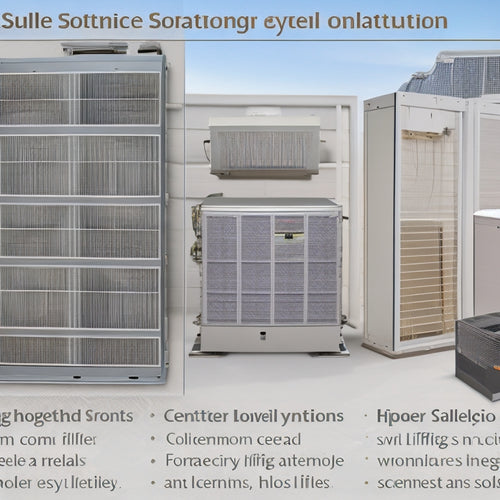
10 Best Permaculture Techniques for Capturing Home Rainwater
Share
You're taking an essential step towards water self-sufficiency by leveraging the power of rainwater, and with the right permaculture techniques, you can collect, store, and employ this precious resource to reduce your reliance on municipal supplies. Effective techniques include designing efficient roof catchment systems, installing gutters and downspouts, and applying first flush devices to reduce contaminants. You'll also want to investigate various rainwater storage options, implement overflow management systems, and consider grey water systems integration and groundwater recharge pits. As you continue to optimize your rainwater capture, you'll uncover even more ways to maximize this free and sustainable resource.
Key Takeaways
- Implement roof catchment systems with suitable materials like metal, asphalt, and concrete to collect rainwater for non-potable uses.
- Install gutter guard systems and downspout extensions to prevent debris accumulation and ensure smooth water flow to storage tanks.
- Use first flush devices to divert initial water flow and reduce contaminants entering storage, and regularly inspect and clean them.
- Select storage options like rain barrels, tanks, or ponds based on specific needs, considering durability, maintenance, and environmental impact.
- Incorporate overflow management systems, like overflow valves and diversion trenches, to prevent waterlogged areas and erosion.
Roof Catchment Systems
Your roof is a goldmine for harvesting rainwater, and with a roof catchment system, you can tap into this precious resource.
The system's efficiency depends on your roof's surface area, material, and slope. A steeper roof slope allows rainwater to flow faster, reducing the risk of waterlogging.
Make certain your roof is made of a material that's suitable for rainwater harvesting, such as metal, asphalt, or concrete. Avoid using roofs with asphalt shingles, as they may contaminate the water.
By installing a roof catchment system, you'll be able to collect and store rainwater for non-potable uses like flushing toilets, washing clothes, and irrigating your garden.
This is a vital step towards independence and reducing your reliance on municipal water supplies.
Gutters and Downspouts Design
You'll want to choose the right gutter material for your system, considering options like aluminum, steel, or PVC, each with its own benefits and drawbacks.
Next, you'll need to decide on a downspout extension strategy to guarantee rainwater flows safely away from your foundation.
Additionally, you may want to install a gutter guard system to keep debris out of your gutters and guarantee a smooth flow of water.
Gutter Material Options
The house's gutter system is only as good as the materials it's made of, and choosing the right gutter material can make all the difference in capturing and directing rainwater effectively. You've got several options to evaluate, each with its pros and cons. Here's a breakdown of popular gutter materials:
| Material | Characteristics |
|---|---|
| Aluminum Gutters | Affordable, corrosion-resistant, and lightweight |
| Vinyl Gutters | Low-maintenance, resistant to rust and corrosion, and budget-friendly |
| Steel Gutters | Durable, strong, and eco-friendly, but may rust if not coated |
| Copper Downspouts | Attractive, durable, and resistant to corrosion, but expensive |
| Seamless Gutters | Continuous, leak-resistant, and custom-fit, but may be pricey |
When selecting a gutter material, assess factors like durability, maintenance, cost, and eco-friendliness. Choose a material that aligns with your rainwater harvesting goals and budget.
Downspout Extension Ideas
Take your rainwater harvesting system to the next level by channeling water from downspouts to where it's needed most - your garden, tank, or storage system.
By extending your downspouts, you can redirect rainwater to areas that need it most, reducing runoff and erosion. Additionally, incorporating energy-efficient solutions, such as solar-powered charging, can further minimize your carbon footprint.
Get creative with downspout landscaping by adding decorative features like rain chains or DIY splash blocks. Consider adding creative extensions like flexible hoses or underground pipes to direct water to your garden beds or storage tanks.
This not only saves you money on your water bill but also reduces your reliance on municipal water supplies, giving you more freedom and control over your water usage.
Gutter Guard Systems
Properly installed gutter guard systems can greatly enhance your rainwater harvesting setup by guaranteeing gutters and downspouts remain clog-free, allowing rainwater to flow freely into your collection system.
With the increasing adoption of Renewable Energy Sources for EV Charging, it's crucial to optimize rainwater harvesting systems to reduce our reliance on traditional energy sources.
You'll appreciate the reduced gutter maintenance tips, as leaves and debris won't accumulate, making gutter cleaning tools a thing of the past.
With a gutter guard system, you can say goodbye to frequent cleaning and hello to more free time.
Look for systems with a durable design, easy installation, and a mesh or screen that allows water to flow through while keeping debris out.
First Flush Devices
When you install a first flush device, you're ensuring that the initial flow of water from your roof, which often carries debris and contaminants, is diverted and doesn't enter your rainwater harvesting system.
Optimizing your solar panel array design like tilt and orientation can also help you save energy and reduce costs. This is especially important if you're planning to use the collected water for drinking, cooking, or irrigation.
Device Installation Tips
Installing a first flush device is a crucial step in capturing rainwater effectively, and it's important to get it right from the start. When installing your device, consider the following tips to guarantee peak performance.
| Tip | Description | Benefits |
|---|---|---|
| Install near the tank | Reduces pipe length, minimizes water loss | Increased water storage, reduced energy consumption |
| Connect to pump installation | Enables automatic controls, efficient water distribution | Simplified system management, reduced labor |
| Confirm proper slope | Facilitates water flow, prevents stagnation | Improved water quality, reduced maintenance |
| Regularly inspect and clean | Prevents clogging, guarantees peak performance | Extended device lifespan, reduced replacement costs |
Flushing Out Debris
How much debris does your rainwater harvesting system collect every time it rains? Leaves, twigs, and other contaminants can clog your system and reduce its efficiency.
That's where first flush devices come in. These devices allow the first flow of water from your roof to be diverted, taking any debris with it, and then allow clean water to flow into your storage tank.
Regular cleaning and maintenance practices monthly checks on electrical connections are essential to prevent dirt and debris buildup, ensuring peak energy efficiency and fleet operation.
Some common debris types you might find in your system include:
- Leaves and branches
- Roofing material particles
- Bird and animal droppings
- Insect and spider webs
- Fine sediment and dust
Rain Barrels and Tanks
You're likely to find that rain barrels and tanks are an important component of any permaculture system, as they provide a cost-effective and efficient way to employ and store rainwater for later use.
When selecting a rain barrel or tank, consider the size and material based on your specific needs. Implementing solar charging solutions, such as those used for electric fleets reducing grid reliance, can also contribute to a more sustainable water management system.
Proper tank placement is vital to guarantee gravity-fed distribution and minimize piping. Regular rain barrel maintenance is necessary to prevent mosquito breeding and bacterial growth. Clean your barrels regularly, and add a screen or mesh to keep debris out.
Water Storage Options
As the rainwater harvesting system begins to take shape, it's essential to evaluate the various water storage options available.
You'll want to take into account factors like water quality, durability, and maintenance requirements when selecting the best option for your needs.
Some popular water storage options include:
-
Concrete tanks: Durable and long-lasting, but may require specialized installation
-
Steel tanks: Affordable and easy to install, but may be prone to corrosion
-
Plastic tanks: Lightweight and easy to handle, but may be prone to cracking
-
Wooden barrels: Aesthetically pleasing, but may require more maintenance
-
Ponds or pools: Ideal for large-scale water storage, but may require significant space and maintenance
Overflow Management Systems
One essential aspect of a well-functioning rainwater harvesting system is the overflow management system, which prevents waterlogged areas, erosion, and potential water pollution.
You'll want to implement overflow prevention strategies to guarantee excess water doesn't accumulate around your storage tanks. Consider installing an overflow valve that directs excess water away from your home's foundation.
Emergency drainage solutions, like a diversion trench or a French drain, can also help redirect overflow water to a safe area.
Groundwater Recharge Pits
Three key benefits come with incorporating groundwater recharge pits into your rainwater harvesting system: reduced stormwater runoff, minimized groundwater pollution, and increased groundwater recharge.
By doing so, you'll not only conserve this precious resource but also enhance your local ecosystem.
Some of the advantages of groundwater recharge pits include:
- Enhancing soil moisture and aquifer restoration through natural filtration and increased infiltration rates
- Raising the water table, making it more accessible for your plants and reducing your reliance on municipal water
- Improving ecosystem services and promoting drought resilience through thoughtful environmental design
- Supporting the health of local wildlife and reducing the burden on stormwater infrastructure
- Increasing your freedom from water bills and enjoying the peace of mind that comes with self-sufficiency
Rainwater Filtration Methods
Catch and store rainwater is one thing, but making it usable for your garden or household is another. To guarantee rainwater quality, you'll need to implement filtration methods that remove sediment and pollutants. You have several eco-friendly options to choose from, each with its own maintenance practices and system efficiency.
| Filtration Technology | Filtration Materials | Maintenance Practices |
|---|---|---|
| DIY Filters | Sand, gravel, charcoal | Regular cleaning, replacement of materials |
| Screen Filters | Metal or plastic screens | Periodic cleaning, replacement of screens |
| Ceramic Filters | Ceramic elements | Occasional cleaning, replacement of elements |
| UV Filters | UV light | Replacement of UV light every 6-12 months |
Remember to test your water regularly to verify the filtration method you choose is effective in improving rainwater quality. By incorporating these filtration methods, you'll be able to enjoy clean and usable rainwater for your garden and household.
Grey Water Systems Integration
Now that you've confirmed your rainwater is clean and free of sediment, it's time to explore another beneficial resource: grey water.
Grey water recycling allows you to reuse water from sinks, showers, and washing machines for irrigation and flushing toilets, reducing your municipal water usage.
To integrate grey water into your system, consider the following:
- Install dual plumbing to separate grey water from black water (sewage)
- Use diverter valves to redirect grey water to your irrigation system
- Implement a grey water treatment system, such as a septic tank or wetland, to remove contaminants
- Connect grey water to your toilet and irrigation systems, reducing your potable water usage
- Monitor and maintain your grey water system regularly to verify it's functioning efficiently
Irrigation and Distribution Networks
Most of your rainwater harvesting system's effectiveness relies on a well-designed irrigation and distribution network.
You'll want to create a system that efficiently delivers water to your plants while minimizing waste. Consider implementing drip irrigation or subsurface irrigation, which reduce evaporation and runoff.
A thoughtful permaculture design will help you optimize moisture retention and seasonal planting. By incorporating native planting and soil amendments, you'll improve the water-holding capacity of your soil.
As you plan your irrigation schedule, keep climate adaptation and water conservation top of mind.
Frequently Asked Questions
Can I Use Rainwater for Drinking and Cooking Purposes?
You can use rainwater for drinking and cooking, but you'll need to guarantee proper rainwater filtration to remove contaminants. Consider health considerations like bacteria, viruses, and heavy metals, and invest in a reliable filtration system to make your rainwater safe for consumption.
Do I Need a Permit to Install a Rainwater Harvesting System?
As you commence your rainwater harvesting expedition, remember that freedom from restrictions is key; you'll need to steer through local guidelines and rainwater regulations, so research and comply with permits required, lest your system be deemed unlawful, curtailing your independence.
How Often Should I Clean and Maintain My Rainwater System?
You'll want to clean and maintain your rainwater system regularly, ideally every 3-6 months, to guarantee rainwater filtration remains effective; schedule system inspections to catch any issues before they become major problems.
Can I Integrate Rainwater Harvesting With Existing Plumbing Systems?
You can definitely integrate rainwater harvesting with your existing plumbing system, but you'll need to take into account rainwater filtration and plumbing modifications to guarantee a seamless connection and safe water use.
Are Rainwater Harvesting Systems Suitable for Apartments and Condos?
You can still capture rainwater in apartments and condos by incorporating urban gardening principles and clever rooftop design, allowing you to collect and employ rainwater for irrigation, even in small spaces, and enjoy the freedom of self-sufficiency.
Related Posts
-

Why Solar HVAC Filters Revolutionize Home Energy Efficiency
By adopting solar HVAC filters, you're shifting your home's energy reliance from fossil fuels to clean, renewable sou...
-

3 Sun-Powered Automated Shades for Energy-Savvy Homes
You're looking to change your home into an energy-savvy haven, and sun-powered automated shades are an essential step...
-

10 Grid-Tied Wind Power Systems for Modern Homes
You're looking for a grid-tied wind power system to utilize wind energy for your modern home. Here are ten options to...


